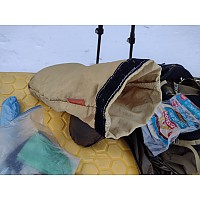Noall Serenity
Noall is no longer in business, and the Serenity has been discontinued. If you're looking for something new, check out the best 3-4 season convertible tents for 2025.
If you are not familiar with Noall tents, the company is a small family owned enterprise operated by Steve Noall. When you call their phone number ~ Steve Noall answers the phone. Steve is very friendly and his VERY personal customer service is excellent.
I purchased this tent four years ago. I was influenced by the great reviews that I had read in Outside magazine about the Noall Mountaineer tent. I liked his Serenity tent but called Steve to ask about adding certain features to it. What I got was a highly customized tent with many features that added weight but made the tent much more versatile. (standard Serenity weighs 6 lbs. 12 oz. by comparison.)
The Serenity is a no-see-um mesh tent that features a strong pole set and a rainfly that goes to the ground. It is sold as a 3/4 season model. The tent features two doors and two foul weather storage areas that are created by unclipping the tent body from the poles on each side and rolling back the tent floor. Even with both sides rolled back, the tent has enough floor space to comfortably sleep two hikers. The tent also features an adjustable-from-the-inside roof vent.
I added full 1.1 oz. polyster ripstop walls and doors, two full mesh doors, and two zip-down fabric covered vents on each end. I also changed the fly fabric from 1.9 oz. ripstop to Titan-Tex (2.1 oz. polyster w/titanium dioxide lamination). This fabric is highly UV resistant, much more waterproof than coated fabric and still fairly lightweight. I used 200 denier oxford nylon w/1.5 oz. coating (total weight-5.5 oz. per sq. yd.) for the bathtub floor, pole sleeves, and zipper flaps. Oxford nylon is much heavier than the 70 denier fabric used on most tents, but you don't need a ground cloth and the tent floor lasts much longer. (The old Holubar company used to use 4 oz. oxford for the tent floors for their expedition models.) Noall uses 200 denier oxford as the standard material on all of their tents now. I also selected a oxford fabric color because the material Steve was using was too bright for my taste. I found the fabric and Steve ordered it in and made the tent for me. Steve sent me fabric samples in the mail to inspect the fabric before the tent was made to see just how strong it was. I also selected .490 diameter poles rather than the standard .340 diameter poles because the tent uses only 3 poles and I wanted it to stand up to high winds and heavy snows. Besides, a 4 pole set out of .340 material would still be heavier than 3 poles made out of .490 material.
I personally believe that a tarp provides perfectly adequate and much lighter shelter for summer backpacking than any tent ~ so I use tents only for really inclement weather and for heavy snows or often in the desert to feebly attempt to stop blowing sand (at least it doesn't blow right into your face). That being said, I think that if you DO need a tent, it should be a strong one and be very versatile to handle most unexpected weather changes.
The tent has performed beautifully over the last four years and I am very pleased with it. I don't know what a tent like this would cost today, but I just received a 2002 price list from Noall tents and I noticed that his prices have gone down by $50-$80 per tent, so I suspect that it would be a little less than I paid.
Knowing the personal service of the company, the quality of construction, the superb materials that are used, the custom features that are available, and the Made-In-USA tag on every Noall product, I really don't understand why anyone would purchase any other brand of tent. I haven't seen any other brand of tent made with this kind of integrity since the 1970s. I LOVE MY NOALL!
Design: freestanding modified dome
Sleeps: 2
Ease of Setup: moderately easy
Weight: 8 .5 ;bs
Price Paid: $550
Your Review
You May Like
Specs
| Price |
Reviewers Paid: $550.00 |


